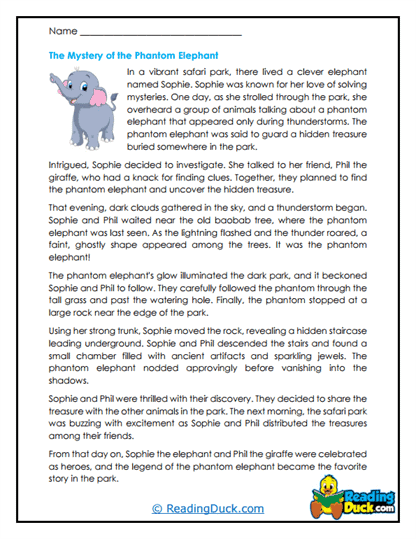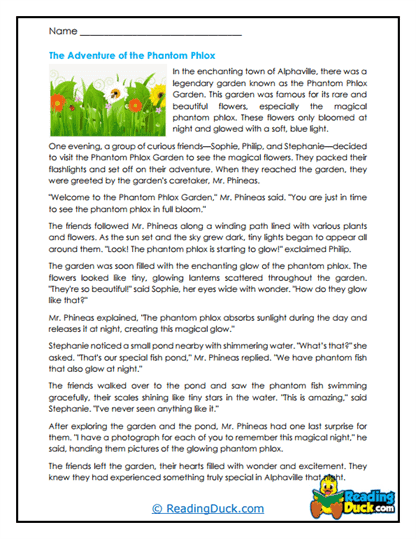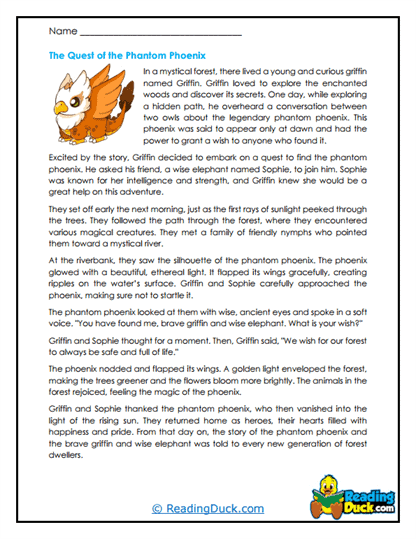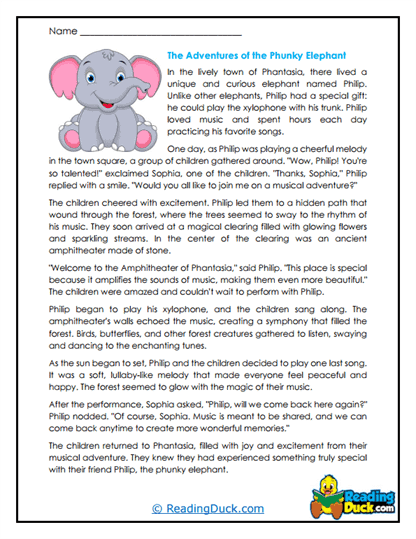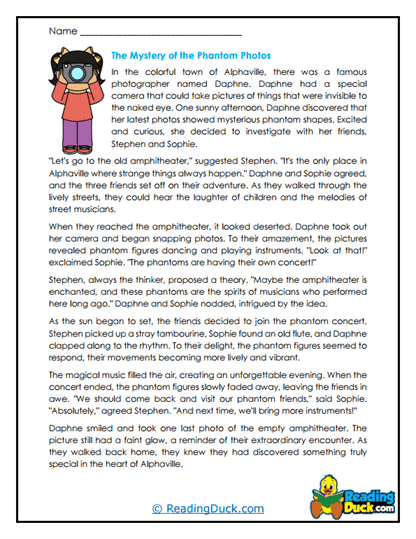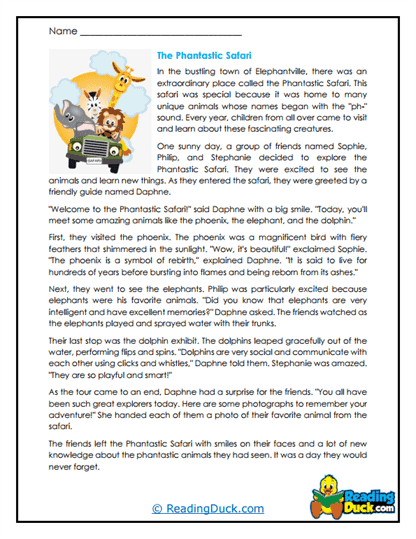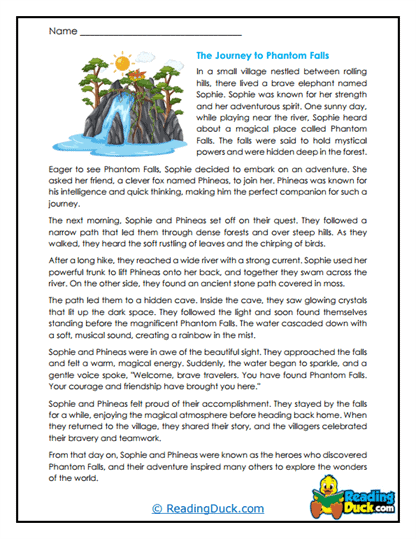Ph Digraph Reading Passages Worksheets
About Our Ph Digraph Reading Passages Worksheets
Our Ph Digraph Reading Passages Worksheets are specially designed to help students master the "ph" digraph, an essential part of early phonics education. Each worksheet in this collection provides a carefully structured reading passage that incorporates words containing the "ph" digraph, helping students recognize and decode this specific sound pattern. Along with the reading passages, each worksheet includes a colorful, engaging picture to capture students' attention and enhance their connection to the content.
To reinforce learning and assess students' understanding, each worksheet comes with multiple-choice comprehension questions that target the phonics concepts and the overall passage. This format helps educators, parents, and tutors gauge how well students are grasping both the phonics sound and the meaning of the text. The worksheets are conveniently provided in PDF format, making them easy to view, download, and print for use in any learning environment. For added convenience, each set includes a downloadable answer key, allowing for quick and accurate grading or review.
The Ph Digraph Reading Passages Worksheets offer a complete learning solution for students, providing valuable phonics practice that strengthens both reading fluency and comprehension, while focusing on a key sound pattern found in many English words.
Understanding the Ph Digraph and Its Importance in Phonics
The "ph" digraph is a combination of the letters "p" and "h" that together produce the /f/ sound, as in words like "phone," "elephant," and "graph." Unlike simple consonant sounds that correspond directly to individual letters, digraphs represent two letters coming together to create one distinct sound. The "ph" digraph is especially important because it often appears in words of Greek origin and is found in both common and more advanced vocabulary.
Mastering the "ph" digraph is crucial for students because it enables them to accurately read and spell a wide range of words. While the /f/ sound can also be represented by the letter "f," recognizing when "ph" is used is an important skill in both reading and spelling. By learning to identify this digraph, students expand their ability to decode unfamiliar words and improve their overall reading fluency.
The "ph" digraph is part of a larger set of digraphs that play a central role in phonics instruction. Other common digraphs include "ch," "sh," "th," and "wh." Each of these digraphs represents a unique sound pattern that students must learn to decode as part of their phonemic awareness. Phonemic awareness is the ability to hear, identify, and manipulate sounds in spoken words, and it is a key predictor of reading success.
Why Learning the Ph Digraph is Important:
- Expands Vocabulary: Many academic and high-frequency words contain the "ph" digraph, so learning this sound pattern helps students access more advanced texts and vocabulary.
- Builds Phonemic Awareness: Understanding the "ph" digraph reinforces the idea that some sounds are represented by letter combinations, which improves students' ability to break down and decode words.
- Enhances Reading Fluency: By mastering digraphs like "ph," students become faster and more accurate readers, as they no longer need to pause to figure out how to pronounce these sound patterns.
- Supports Spelling Development: Learning when and how to use "ph" in words helps students improve their spelling, particularly with words of Greek origin or more advanced vocabulary.
Supporting Phonics Skills and Fluency with Ph Digraph Passages
Our Ph Digraph Reading Passages Worksheets are designed to provide students with repeated exposure to the "ph" sound in a variety of contexts. By reading passages that focus on this specific digraph, students build their ability to decode words containing the "ph" sound and apply this knowledge to their broader reading skills. These worksheets are structured to reinforce phonics concepts while helping students develop fluency, comprehension, and vocabulary.
How These Worksheets Help Build Fluency:
- Targeted Phonics Practice: The worksheets focus specifically on the "ph" digraph, providing multiple opportunities for students to see and practice decoding words with this sound pattern. This concentrated exposure helps students internalize the sound-spelling connection.
- Improving Reading Fluency: As students repeatedly encounter words with the "ph" digraph in meaningful reading passages, they become more comfortable recognizing and pronouncing these words. This leads to smoother and more fluent reading, reducing the need to pause and decode each word.
- Strengthening Comprehension: The comprehension questions included with each worksheet challenge students to not only decode the words but also to understand the meaning of the passages. This balance between decoding and comprehension supports students’ overall literacy development.
Practical Tips for Using Ph Digraph Worksheets in Different Settings
Our Ph Digraph Reading Passages Worksheets are flexible resources that can be used in a variety of learning environments, from the classroom to home study or one-on-one tutoring sessions. They are ideal for supporting students at different stages of their phonics journey, whether they are being introduced to the "ph" digraph for the first time or need additional practice to reinforce what they’ve learned.
Suggestions for Effective Use:
- Small Group Phonics Instruction: In a small group setting, these worksheets can be used to provide focused instruction on the "ph" digraph. Teachers can guide students through the reading passage, helping them decode words and discuss the comprehension questions together. This collaborative approach allows students to learn from each other and deepen their understanding of the phonics concept.
- Independent Reading Time: Assign the worksheets as independent reading practice, allowing students to work through the passage and answer comprehension questions at their own pace. This helps them develop self-sufficiency in applying their phonics skills and boosts confidence in reading.
- Supplementary Phonics Review: These worksheets are excellent as a review tool for students who have already learned the "ph" digraph in class. They offer a structured way for students to revisit the concept, apply it in context, and reinforce their knowledge.
- Homework Assignments: Because the worksheets are provided in PDF format, they can easily be printed and sent home for extra practice. Parents can use the worksheets to reinforce phonics lessons at home, helping their child build stronger reading skills.
- Tutoring Sessions: For one-on-one tutoring, these worksheets offer a focused and engaging way to teach or reinforce the "ph" digraph. Tutors can work closely with students, helping them decode "ph" words, read the passages, and answer comprehension questions.
Reinforcing Phonemic Awareness Through Repetition
One of the key benefits of the Ph Digraph Reading Passages Worksheets is the repeated exposure they provide to the "ph" digraph. Phonemic awareness—the ability to hear and manipulate sounds in words—is developed through consistent and structured practice. The more frequently students encounter the "ph" digraph, the more confident they become in recognizing and applying this sound pattern when reading and spelling.
Why Repeated Practice is Essential:
- Boosts Word Recognition: Repeated exposure to the "ph" digraph helps students recognize this sound pattern more quickly in future reading tasks. This improved word recognition leads to faster, more accurate reading.
- Builds Confidence: As students gain familiarity with "ph" words, their confidence in reading grows. They are more likely to tackle new and unfamiliar texts with ease, knowing they have the tools to decode challenging words.
- Improves Decoding Skills: The consistent practice provided by these worksheets enhances students’ ability to break down words into individual sounds and letter combinations, which is a crucial skill for becoming a fluent reader.
Vocabulary Expansion Through Ph Digraph Reading Passages
In addition to improving phonics and fluency, the Ph Digraph Reading Passages Worksheets also help students expand their vocabulary. Each reading passage contains a range of "ph" digraph words, introducing students to new and advanced vocabulary in a meaningful context. By encountering these words in full sentences and stories, students gain a deeper understanding of word meanings and usage.
Key Benefits of Vocabulary Building:
- Contextual Learning: Seeing "ph" digraph words used in meaningful passages helps students understand their usage and meaning in context, making vocabulary acquisition more natural and intuitive.
- Broader Language Development: Learning new words with the "ph" digraph strengthens students’ overall language skills, giving them a wider range of vocabulary to use in both reading and writing.
- Real-World Application: The words learned through these worksheets can be applied to other reading and writing tasks, helping students grow their language abilities and tackle more complex texts.
Conclusion
Our Ph Digraph Reading Passages Worksheets are a powerful tool for helping students master the "ph" digraph, an important component of early phonics education. These worksheets provide targeted phonics practice through engaging reading passages, colorful illustrations, and comprehension questions, ensuring that students build fluency, enhance comprehension, and expand their vocabulary. Whether used in the classroom, during tutoring sessions, or at home, these worksheets offer flexible and effective resources for reinforcing phonics lessons and supporting students on their journey toward becoming confident, fluent readers. With repeated exposure to the "ph" digraph, students will strengthen their decoding skills and be well-prepared to succeed in all aspects of literacy.

